Research - (2021) Volume 9, Issue 4
Incidence of Asymptomatic Gall Bladder Stones in the General Population
Sinkhol Laishram and Santhaseelan RG*
*Correspondence: Santhaseelan RG, Department of General Surgery, Sree Balaji Medical College & Hospital, India, Email:
Abstract
Background: The study was designed to assess the prevalence of asymptomatic gallstone disease in patients admitted to various specialties of Sree Balaji Medical College and Hospital between October 2013 to October 2015.
Materials and methods: The medical history and other clinical data were collected along with ultrasonograpghy, microbiological evaluation and biochemical analysis. They subjected to subjected to laparoscopic cholecystectomy or open cholecystectomy based on GB calculi severity. All patients received peri-operative antibiotic.
Results: Out of 800 admitted patients, 60 were diagnosed with the different types of calculi. Women were more for disease than men and the patients in late 50s were more prone for calculi development. A direct correlation with diabetes, low socio-economic conditions and unhealthy dietary habits were recorded. etc. E. coli was the commest pathogen on gall infection among the patients. Their histopathological analysis showed no malignancy.
Conclusion: The study revealed needs the proper and systematic evaluation for calculi in aged people. The healthier life would minimize the disease severity. Non-neoplastic lesions were more common till 50 years. The present study also revealed that the early detection could be especially useful in managing the gall bladders.
Keywords
Gallbladder, Kidney stone, Age and calculi, Microbial analysis in calculi, Ultrasonography
Introduction
Medical dissolution of stone though theoretical, is not very popular with our hospital patients because of non- availability, and also high chances of developing complications such as acute/chronic cholecystitis, jaundice, pancreatitis etc. Laparoscopic cholecystectomy is now replacing open cholecystectomy, with availability of instrument, more of laparoscopic cholecystectomy is being carried out replacing open cholecystectomy. However open cholecystectomy has its own indications. It is therefore necessary that a surgeon should have adequate knowledge and experience in this field. Open CBD exploration is being followed in us institution because of lack of expertise in laparoscopic CBD exploration in general surgery and availability of ERCP in our hospital help to remove distal CBD stones and its failure makes us to go for open surgical procedure. Prevalence of asymptomatic gallstone disease was found in 6% apparently healthy subjects of North- East part of Bangladesh. It was more prevalent among housewives and middle-class group of population. It is also common among the people of age group below 40 years.
Gallbladder stone disorders (GSD) are extremely common among the people and usually asymptomatic. The extra-hepatic biliary calculi are the prevalent type of gallbladder disorder and approximately 95% of people affected by it. It is more common in western world but, India also facing an increase in its epidemiology due to lifestyle modifications. Though, the exact reason had not been well studied, the prevalence is estimated to 4% and 6% among men and women respectively. Because of extensive studies of etiology of gallstone disease and better understanding of pathogenesis and technological advancements in past three decades, the management has become more appropriate and effective.
The intensive research on gallbladder has brought new advancements in therapeutics and the minimal invasive surgeries such as laparoscopic cholecystectomy, endoscopic had reduced the mortality and morbidity associated with gallbladder disorders. Though, constraints are existing in the diagnosing and eventually resulting in improper management of disorders. The present study aimed to analyses the prevalence an dincidence of asymptomatic GSD in patients admitted the Sree Balaji Medical college and Hospital, Chrompet, Chennai.
Aim and Objectives
✓ To evaluate the incidence of asymptomatic GB calculi and asymptomatic GB calculi associated with CBD calculus.
✓ To evaluate age, sex, incidence, most common etiological factors for GB calculi
✓ To illustrate varying clinical presentation
✓ To study various modes of management adopted in our institution.
✓ To analyses the biochemical types of stones prevalent in this part of country.
Materials and Methods
The patients admitted in various specialties of Sree Balaji Medical College and Hospital between October 2013 to October 2015 analyzed for the presence of cholelithiasis and cholelithiasis with choledocholithiasis without symptoms of cholelithiasis/CBD calculus and its complications and they were included this study. A total of 60 patients were studied. A detailed history including dietary factors, lifestyle habits, were elicited thorough a clinical examination and diagnosis was made on routine USG abdomen. Further, all patients were subjected to basic blood, urine and biochemical evaluation including liver function test and USG abdomen. CT scan abdomen, MRCP were done in selected subjects. Initially, patients were on routine follow-up and asked for operative management based on their disease severity. The operative findings were correlated with epidemiological factors with respect to age, sex distribution. The bile ducts were analyzed for bacteriological examination and the respective stones were undergone for biochemical analysis.
In all jaundiced patients, prolonged prothrombin time was corrected using IM injection for 3 days prior to surgery. The patients were subjected to laparoscopic cholecystectomy or open cholecystectomy based on GB calculi severity. All patients received peri-operative antibiotic.
Results
Totally 60 patients were included in the study and the GBD prevalence was seemed to be higher in females (60%) than males (40%). This result showed that there was a discrete sex determination on GBD prevalence (Figure 1).
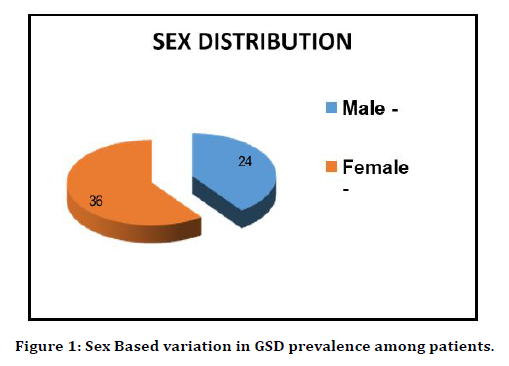
Figure 1. Sex Based variation in GSD prevalence among patients.
The GBD occurrence was also varied with the age of the patients. The disease was seemed to strongly affect the people in their early 50s and GB + CBD calculi was higher prevalent in people who were more than 50 years. %) GB calculi were prone in people lesser than 50 years old. This result showed the disease severity would be proportional to the aging (Figure 2). The patients showed variation in stone location also. GB calculi was more prone in patients followed by GB + CBD calculi (Table 1 and Figure 3).
| Class | No. of cases | Percentage (%) |
|---|---|---|
| GB calculi | 41 | 68.30% |
| GB + CBD calculi | 19 | 31.70% |
| Total | 60 | |
Table 1: Location of stone in GBD patients.
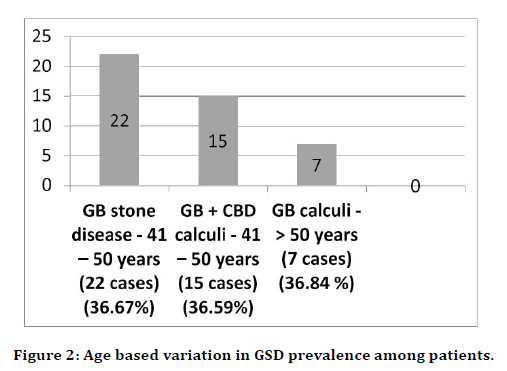
Figure 2. Age based variation in GSD prevalence among patients.
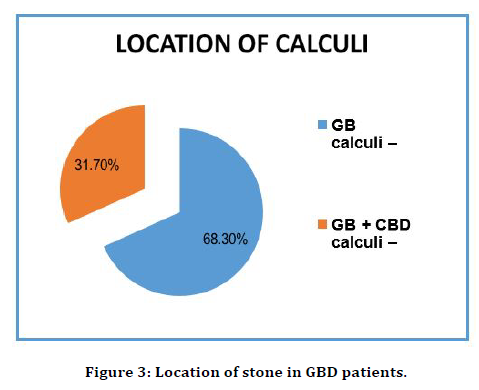
Figure 3. Location of stone in GBD patients.
The Clinical presentation of the GB calculi was mostly associated with diabetes (40%) followed by Gastritis (20%) and Chronic cholecystitis (6.7%). Mucocoele was found to be least (2.4%) among the studied patients (Figure 4). The gastritis: 7 (11.7%) and Pancreatitis (10.5%) was found to be associated with the GB + CBD calculi. DM (16.7%) also found as a prominent clinical presentation among the patients suffering with GB + CBD calculi (Figure 5).
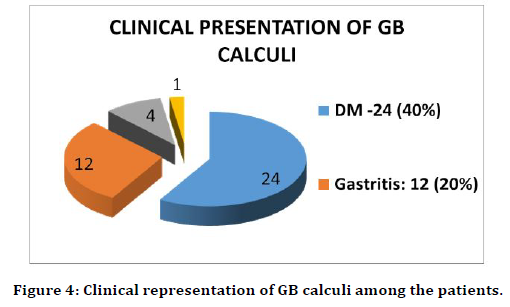
Figure 4. Clinical representation of GB calculi among the patients.
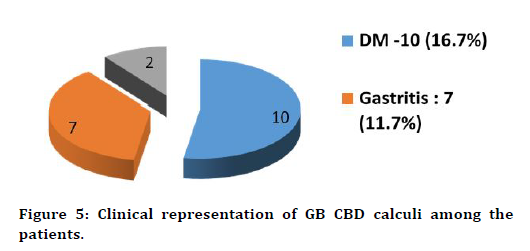
Figure 5. Clinical representation of GB CBD calculi among the patients.
Preoperative ultrasonography could be used as a valuable screening method against complicated laparoscopic cholecystectomy. In the present study, it was used to analyses the GB calculi. Its accuracy was 100%. Different procedures were performed in the present study using the ultrasonography (Figures 6 and 7). The stones are painful medical conditions. The present study revealed that the variation in the stone formations in the studied patients. Single and multiple stones were found in both sex (Table. 2 and Figure. 8), but, frequency of multiple stone was higher in women (67.7%) patients than male (33.3%).
| Single stone | Multiple | |
|---|---|---|
| Male | 9 | 15 |
| Female | 11 | 25 |
| Total | 20 (33.3%) | 40 (67.7%) |
Table 2: Number and types of stones found in patients.
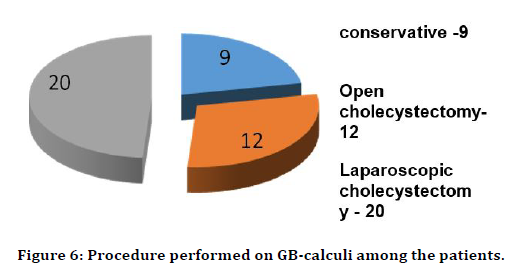
Figure 6. Procedure performed on GB-calculi among the patients.
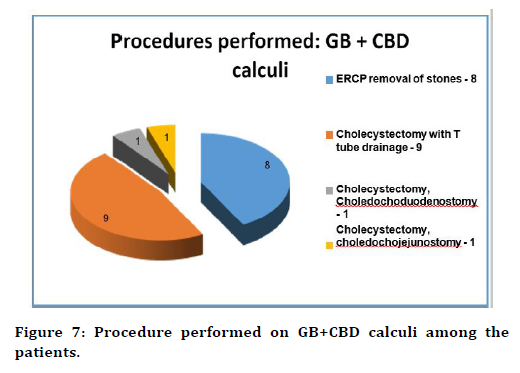
Figure 7. Procedure performed on GB+CBD calculi among the patients.
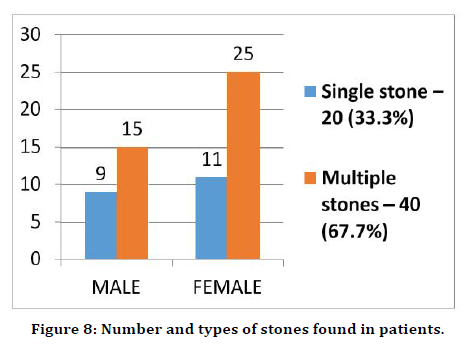
Figure 8. Number and types of stones found in patients.
The bacteriology of the bile duct revealed the infection status of the operated patients. E. coli (63.1%) was frequently seen in the bile ducts followed by Klebsiella sp. (21%) (Figure 9). In the present study, clinically diagnosed and postoperatively collected gall stones (Table 3 and Figure 10) were analyzed to know their chemical composition, such as cholesterol, triglycerides and bilirubin and to evaluate the risk factors which were responsible for the causation of biliary calculi. The results showed that mixed stones were prominent on both type of calculi with much higher in GB calculi (9.7%) and GB + CBD calculi (8.3%).
| GB calculi | GB+CBD calculi | Total | |
|---|---|---|---|
| Cholesterol stone | 4 (9.7%) | 1 (5.3%) | 5 (8.3%) |
| Pigment stone | 3 (7.3%) | 2 (10.5%) | 5 (8.3%) |
| Mixed stone | 34(82.9%) | 16 (84.2%) | 50(83.3%) |
| Total | 41 | 19 | 60 |
Table 3: Biochemical analyses of stone in bile ducts.
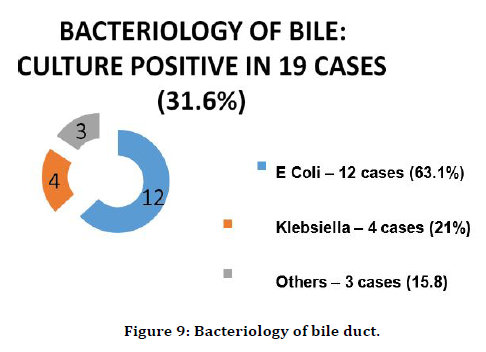
Figure 9. Bacteriology of bile duct.
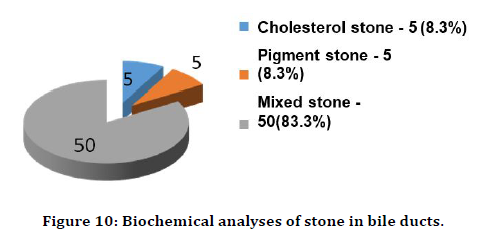
Figure 10. Biochemical analyses of stone in bile ducts.
The gallbladder was analyzed histopathologically (N=60). In non-neoplastic lesions, chronic cholecystitis contributed the majority of the cases (96.7%), followed by acute cholecystitis (3.3%). None of the specimen showed any malignancy (Figure 11). Diseases severity had a direct effect on hospital stay. In the present study, patients’ hospital stay was also analyzed from the medical data. The results revealed that the patients with CBD were stayed more days (10 days) followed by Open cholecystectomy (7 days) and Laparoscopic cholecystectomy (3 days). Post operatively during second week T tube cholangiogram was performed in 9 Cases. Found to be normal in all cases. No evidence of residual calculi (Figure 12).
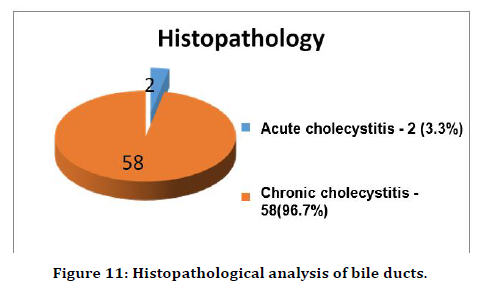
Figure 11. Histopathological analysis of bile ducts.
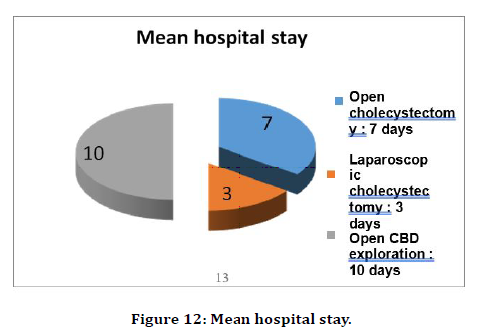
Figure 12. Mean hospital stay.
60 Patients with asymptomatic (initial) extrahepatic biliary calculi were included in this study and diagnosed on routine USG abdomen examination. The results showed a direct correlation of age and biliary calculi. The patients in late 40s were more prone for development of calculi. The study also revealed that the sex was an important factor for calculi development and the females were more than males. These results were concordant with the previous studies series [1-4]. The patients revealed the abdominal pain at right hypochondrium as the major medical indication against the calculi and it was correlated with the previous study done by Vijaypal et al. [5]
Majority of asymptomatic gallstone disease patients developed chronic cholecystitis (92.7 %) during initial follow-up and other complications being acute cholecystitis and mucocoele. Majority of GB+CBD calculi patients developed Obstructive jaundice (78.9%) also. Previously, Mesherry et al. [4] and Schwartz et al. [6] reported similarly and Williams et al. [7] had showed that multiple calculi as one the major complications associated with calculi development. No iatrogenic bile duct injury was recorded in our study. Similarly, other studies reported reported 0% injuries on treatment. Besides, few other studies reported the occurrence of mild to severe injuries in contrast to our present study (Mc sherryet al. [8]–0.6- 4%, Goswitz et al. [9] 0.5%). No mortality was occurred in our study. E coli was the commonest organism isolated from gallbladder followed Klebsiella sp. and concordant with Hopper et al. [10] and Goswitz et al. [9]. In our study, we found 83.3% of stones were of mixed type as compared to Vijay pal et al (91.3%) [5].
Conclusion
Gallstone disease is the commonest disease involving biliary tract and is associated with significant morbidity and mortality. Patients with gallstones are not a homogenous group. They are now being detected with greater frequencies with advent of USG and CT scan. The study revealed that the age, sex plays a significant role in disease severity. Our study revealed that the mixed stones were common among the females that males. Our study also revealred that the proper management of diabetic and life styles would minimize the development of the disease.
Funding
No funding sources.
Ethical Approval
The study was approved by the institutional ethics committee.
Conflict of Interest
The authors declare no conflict of interest.
Acknowledgments
The encouragement and support from Bharath University, Chennai is gratefully acknowledged. For provided the laboratory facilities to carry out the research work.
References
- https://books.google.co.in/books/about/Essential_Surgical_Practice_4Ed.html?id=i-lgQgAACAAJ&redir_esc=y
- Cusheiri A, bersly G. Laparoscopic cholecystectomy. Am J Surg 1990; 159:273.
- Bowen JC, Brenner HI, Macle WF. Gallstone disease pathophysiology epidemiology, natural history and treatment options. Med Clin North Am 1992; 76::1143–1157.
- Mesherry. North American clinics of gastroenterology. 3rd Edn. 1989.
- Pal V. Clinicopathological study of cholecystitis. IJS 426–431.
- https://books.google.co.in/books/about/Sabiston_Textbook_of_Surgery_17th_Editio.html?id=8b_IRwAACAAJ&redir_esc=y
- Williams EJ, Green J, Beckingham I, et al. Guidelines on the management of common bile duct stones (CBDS). Gut 2008; 57:1004-21.
- McSherry CK. Cholecystectomy: The gold standard. Am J Surg 1989; 158:174-178.
- Goswitz JT. Bacteria and biliary tract disease J Surg 1974; 128:644-646.
- Hopper KD, Landis JR, Meilstrup JW, et al. The prevalence of asymptomatic gallstones in the general population. Investigative Radiol 1991; 26:939-945.
Author Info
Sinkhol Laishram and Santhaseelan RG*
Department of General Surgery, Sree Balaji Medical College & Hospital, Chromepet, Chennai, IndiaCitation: Sinkhol Laishram, RG Santhaseelan, Incidence of Asymptomatic Gall Bladder Stones in the General Population, J Res Med Dent Sci, 2021, 9 (4): 387-391.
Received: 20-Mar-2021 Accepted: 21-Apr-2021
